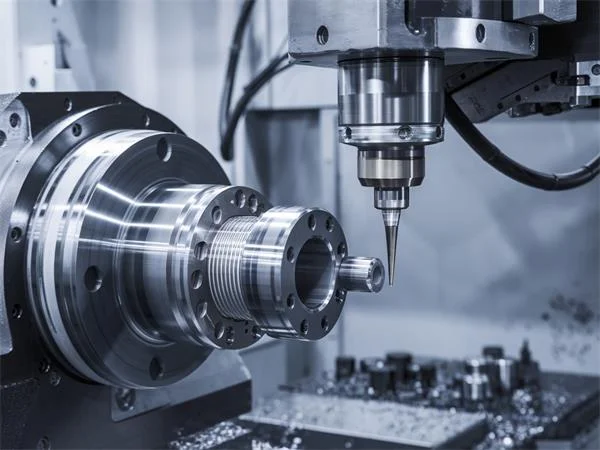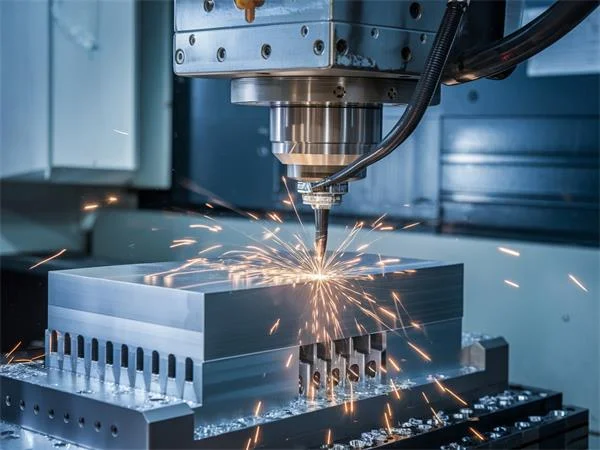CNC Machining Parts: Understanding the Role of Material Hardness in Precision Manufacturing
CNC machining is at the heart of modern manufacturing, delivering precision, efficiency, and versatility across countless industries. One critical factor determining the quality and performance of machined parts is material hardness. Whether you’re working with metals, plastics, or composites, understanding and managing hardness is essential for achieving optimal machining results.
In this article, we’ll explore how material hardness influences CNC machining processes, its challenges, and how manufacturers overcome these hurdles to produce high-quality parts.

What is material hardness?
Material hardness refers to a material’s ability to resist deformation, scratching, or indentation. It is often measured using scales such as Brinell (HB), Rockwell (HRC), or Vickers (HV). Hardness is a key property for determining how a material responds to machining and plays a vital role in deciding the cutting tools, machining strategies, and end-use applications of CNC-machined parts.
How Hardness Impacts CNC Machining
1. Tool Wear and Durability
Harder materials, like hardened steel or titanium alloys, are more challenging to machine. They cause rapid tool wear, reducing the lifespan of cutting tools and increasing operational costs. To address this, manufacturers use specialized cutting tools made from high-speed steel (HSS), carbide, or coated materials like titanium nitride (TiN).
2. Cutting Speed and Feed Rate
The hardness of the workpiece material dictates the cutting parameters. For harder materials, slower cutting speeds and lower feed rates are essential to avoid excessive heat generation and tool breakage. Conversely, softer materials allow for faster machining but require precision to avoid deformation or tearing.
3. Surface Finish
Harder materials often yield smoother finishes due to their resistance to plastic deformation. However, achieving this finish requires precise control of tool sharpness and machining conditions. Softer materials, while easier to machine, can develop surface defects like burrs if not handled carefully.
4. Machining Forces
Hard materials require higher machining forces, which can strain both the machine and the cutting tools. CNC machines designed to handle high-hardness materials are equipped with robust spindles, rigid structures, and advanced cooling systems to dissipate heat.
Common Hard Materials in CNC Machining
1. Hardened Steel
– Application: Gears, moulds, and tooling components.
– Challenges: High cutting forces and heat generation.
– Solutio n: Use of coated carbide tools and high-pressure cooling.
2. Titanium Alloys
– Application: Aerospace parts, medical implants.
– Challenges: Low thermal conductivity and high strength.
– Solution: Lower feed rates and advanced tool geometries.
3. Stainless Steel (HRC 30–40)
– Application: Automotive and food industry components.
– Challenges: Work hardening and tool wear.
– Solution: Sharp cutting tools and constant cutting speeds.
4. Aluminum Alloys
– Application: Structural and decorative parts.
– Characteristics: Comparatively soft but can be hardened through heat treatment.
– Solution: High-speed machining with proper chip evacuation.

Machining Strategies for Hard Materials
1. High-Performance Cutting Tools
Tools made from carbide, ceramics, or cubic boron nitride (CBN) are preferred for machining hard materials. Their superior hardness and thermal stability ensure extended tool life and precise cutting.
2. Optimized Cooling and Lubrication
Coolants and lubricants are crucial in dissipating heat and reducing friction during machining. Techniques like high-pressure coolant delivery and cryogenic cooling are effective for hard material machining.
3. Adaptive Machining
Modern CNC machines are equipped with sensors and software that adapt cutting parameters in real-time to manage tool wear and maintain consistent performance, even with hard materials.
4. Pre-Hardening or Post-Machining Heat Treatment
In some cases, materials are pre-hardened before machining to reduce deformation risks. Alternatively, parts can be machined in a softer state and then heat-treated to achieve the desired hardness.
Balancing Hardness and Machinability
While harder materials offer superior strength, wear resistance, and durability, they are inherently more challenging to machine. This creates a trade-off between material hardness and machinability. Engineers and designers must carefully select materials based on the functional requirements of the part, manufacturing capabilities, and cost considerations.
For example:
– For high-strength applications like aerospace or defence, materials like titanium or tool steels are chosen despite their machining challenges.
– For less demanding applications, softer materials like aluminium alloys or plastics can balance machinability and performance.
Material hardness is a defining factor in CNC machining, influencing everything from tool selection to machining strategies and final product quality. By understanding the relationship between hardness and machinability, manufacturers can optimize their processes to handle both soft and hard materials effectively.
CNC machining has evolved to meet the demands of working with increasingly harder materials, driven by innovations in tooling, cooling, and machine technology. This progress ensures that the industry continues to produce parts that are not only precise but also robust enough to meet the needs of a rapidly advancing world.
Hardness vs. Other Material Properties
Hardness is an important property, but it doesn’t exist in isolation. In CNC machining, hardness interacts with other material characteristics, creating additional challenges and opportunities:
1. Toughness
Toughness refers to a material’s ability to absorb energy without fracturing. While hard materials resist deformation, they can be brittle (e.g., ceramics). In contrast, tough materials like certain alloys balance strength and ductility, making them easier to machine while still being durable.
2. Thermal Conductivity
Materials with low thermal conductivity, like titanium, tend to retain heat during machining. This leads to localized heating at the cutting edge, accelerating tool wear. CNC strategies often include enhanced cooling systems to counteract this effect.
3. Work Hardening
Certain materials, such as stainless steel, become harder when deformed under pressure—a phenomenon known as work hardening. This can make subsequent machining steps more difficult. To manage work hardening, machinists often use sharp tools, optimized cutting speeds, and continuous cutting techniques to minimize interruptions.
4. Surface Treatments
Some materials receive surface treatments, such as nitriding or case hardening, to increase their surface hardness while maintaining a softer core. This creates a dual-hardness structure, requiring careful machining to avoid chipping or cracking the hard outer layer.
Specialized Techniques for Hard Material Machining
Advances in machining technologies have unlocked new ways to efficiently machine hard materials.
1. Electrical Discharge Machining (EDM)
EDM uses electrical discharges (sparks) to remove material from hard workpieces. This is particularly effective for extremely hard or brittle materials like tool steels or ceramics that are difficult to machine using conventional methods.
2. Laser-assisted machining (LAM)
In LAM, a laser preheats the workpiece material just ahead of the cutting tool. This localized heating temporarily softens the material, making it easier to machine while preserving its overall hardness.
3. Ultrasonic-Assisted Machining (UAM)
UAM combines traditional cutting with ultrasonic vibrations to reduce cutting forces and improve tool life. It’s particularly effective for machining hard and brittle materials, such as tungsten carbide and advanced ceramics.
Material Hardness in Additive vs. Subtractive Manufacturing
The rise of additive manufacturing (AM) has introduced new opportunities for working with hard materials. In some cases, components are 3D-printed in softer states and then hardened through heat treatment, bypassing the challenges of machining hard materials. However, CNC machining often follows additive processes to refine dimensions or improve surface finish, highlighting the complementary roles of these technologies.
Hardness in Tooling Materials
The success of machining hard materials heavily depends on the hardness and durability of the cutting tools themselves. Here’s a closer look at common tooling materials and their applications:
Carbide Tools
Ideal for hard metals like steel and titanium, offering excellent wear resistance and thermal stability.
Ceramic Tools
Used for high-speed machining of superalloys, as they can withstand extreme temperatures without deforming.
Cubic Boron Nitride (CBN)
Among the hardest cutting materials, CBN tools are effective for machining hardened steels and cast irons.
Diamond Tools
Used for ultra-precise machining of non-ferrous materials and composites, achieving unparalleled smoothness.
Case Studies: Applications of Hardness in CNC Machined Parts
1. Aerospace Industry
Aircraft components, such as turbine blades and engine housings, require materials that can withstand high temperatures, extreme pressures, and wear. Titanium and Inconel are common choices, but their hardness demands advanced CNC techniques and tooling.
2. Medical Devices
Surgical instruments and implants often use hardened stainless steel or cobalt-chrome alloys for biocompatibility and durability. Achieving the required precision and surface finish for these materials requires meticulous control of machining parameters.
3. Automotive Industry
Gears, camshafts, and crankshafts are often made from hardened steel to endure high stresses and wear. CNC machining ensures these components meet tight tolerances and have the necessary surface finish for optimal performance.
Future Trends in Machining Hard Materials
1. Hybrid Manufacturing Systems
Combining additive and subtractive methods allows manufacturers to produce hard material components with intricate geometries and minimal material waste.
2. Artificial Intelligence in Machining
AI-driven systems are being used to optimize tool paths, predict tool wear, and adjust machining parameters in real-time, improving efficiency when working with hard materials.
3. Advanced Coatings
Tool coatings are becoming increasingly sophisticated, with multilayer technologies that combine wear resistance, heat dissipation, and reduced friction. These advancements are critical for machining hard materials at higher speeds.
4. Sustainability in Hard Material Machining
As industries emphasize sustainable practices, manufacturers are exploring ways to minimize waste and energy use during the machining of hard materials, such as through improved coolant recycling and energy-efficient CNC machines.
Material hardness is more than just a challenge—it’s an opportunity to innovate. As machining technologies evolve, manufacturers are finding new ways to handle harder materials with greater precision and efficiency. Whether it’s through advanced tooling, adaptive machining strategies, or integrating AI into the process, the future of CNC machining promises even greater possibilities for working with the toughest materials.
Understanding and managing hardness is not just about cutting through a tough workpiece; it’s about pushing the boundaries of what’s possible in modern manufacturing.